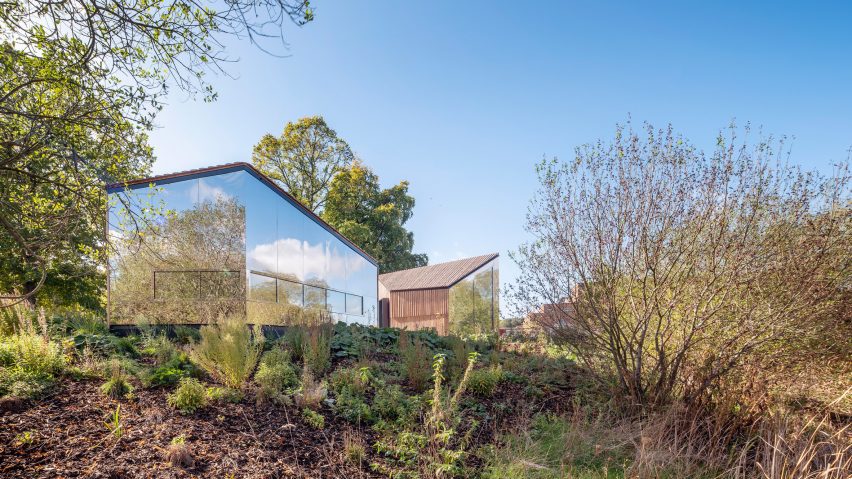Mirrored panels and Siberian larch cladding characterise Harwell Hide, a cluster of workspace pavilions designed by London studio Bell Phillips to blend into its surroundings in Oxfordshire.
Located at the rural Harwell Science and Innovation Campus, the angular pavilions are constructed from cross-laminated timber (CLT) and set on tubular steel foundations to touch the landscape lightly.
The workspaces, named Working Hide, Informal Hide and Utility Hide, were designed by Bell Phillips for a site overlooking a small lagoon.
They were commissioned by the science campus as part of a wider investment plan that is intended to provide additional space for workers and collaborators on the site.
"The Harwell Hide project is part of an ambitious campus investment plan, making room for more people and organisations to join the Harwell community with cutting edge workplace, new labs and world-leading facilities," said studio co-founder Hari Phillips.
"The hides have been designed as an environment for innovation, as workspaces that people will want to come back to, and as a retreat for people working at Harwell," he continued.
The pavilions are designed to have a "simple, serene and sculptural" presence in the green landscape.
Externally, they are clad alternately in mirrored panels and ribbed panels of Siberian larch that will gradually turn grey as they weather.
"Materiality is key," explained Phillips. "Naturally silvering Siberian larch cladding blends with the surrounding trees and grassland, and over time will weather back and fade into the setting," it said.
To prevent the risk of bird collisions with the mirrors, Phillips said that the panels have been set at an angle and broken up by various openings.
"The mirrored panels are each set at an angle to help prevent bird collisions, and the faceted design of the pavilions created contrast," he explained.
"Each panel is relatively small in relation to the cluster of pavilions, and as well as the angled arrangement, they contain door and window openings to not appear as a continuous plane."
Inside each Harwell Hide pavilion, the structural CLT panels are left exposed, forming a backdrop to simple black furnishings and lighting fixtures.
Large bespoke desks follow the angles of the envelope, positioned beneath long ribbon windows offering views of the landscape.
"Each hide uses the entirety of its internal envelope, with large openings to create light and airy interiors, while celebrating the striking angularity of their structures," Phillips said.
"The interiors have been designed as simple spaces to minimise maintenance demands and costs, with bespoke timber furniture used sparingly."
Bell Phillips was founded in London in 2004 by Tim Bell and Phillips. The studio's previous projects include a timber "tree house" pavilion and viewing gallery at London's Elephant Park, and a curving, white brick pavilion overlooking a lake in Southwark Park.
The photography is by Kilian O'Sullivan.

